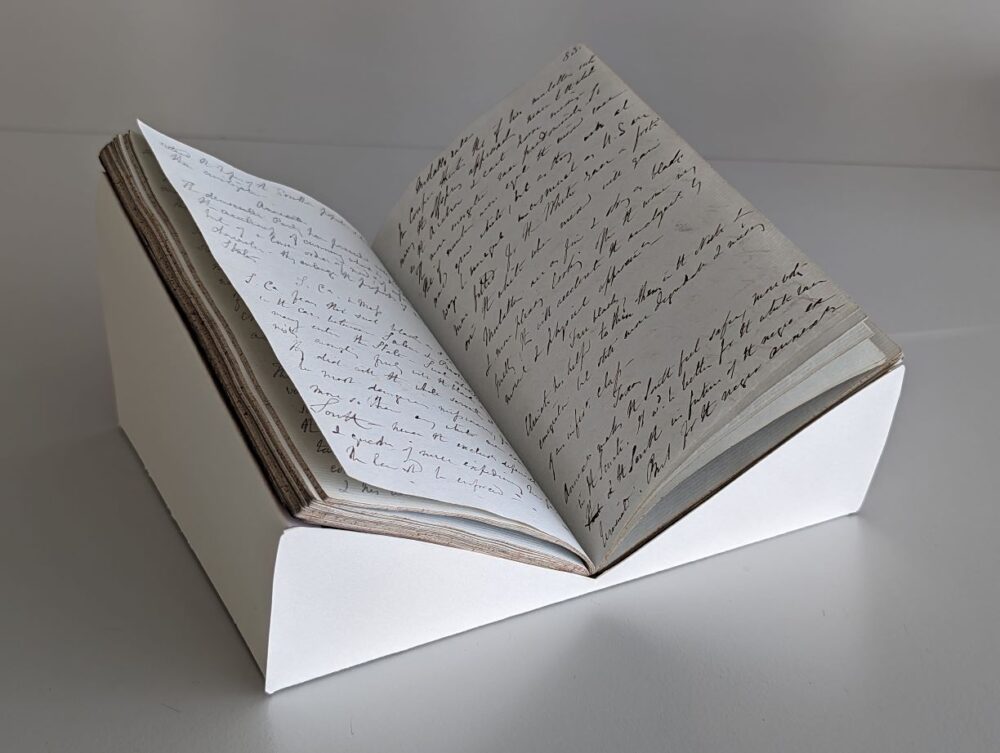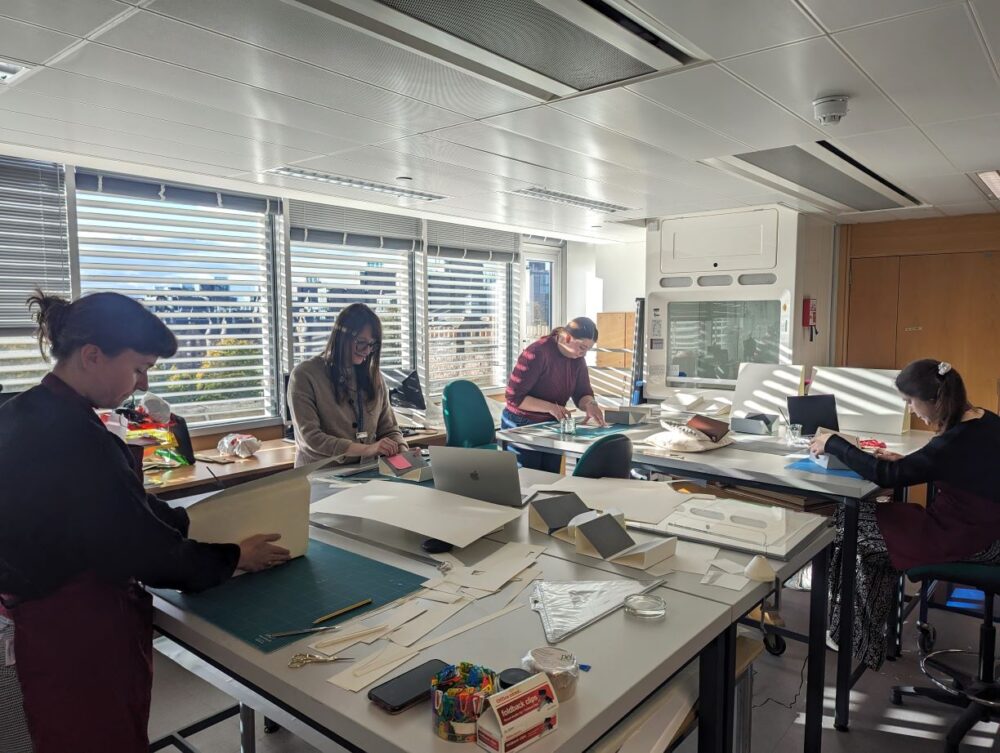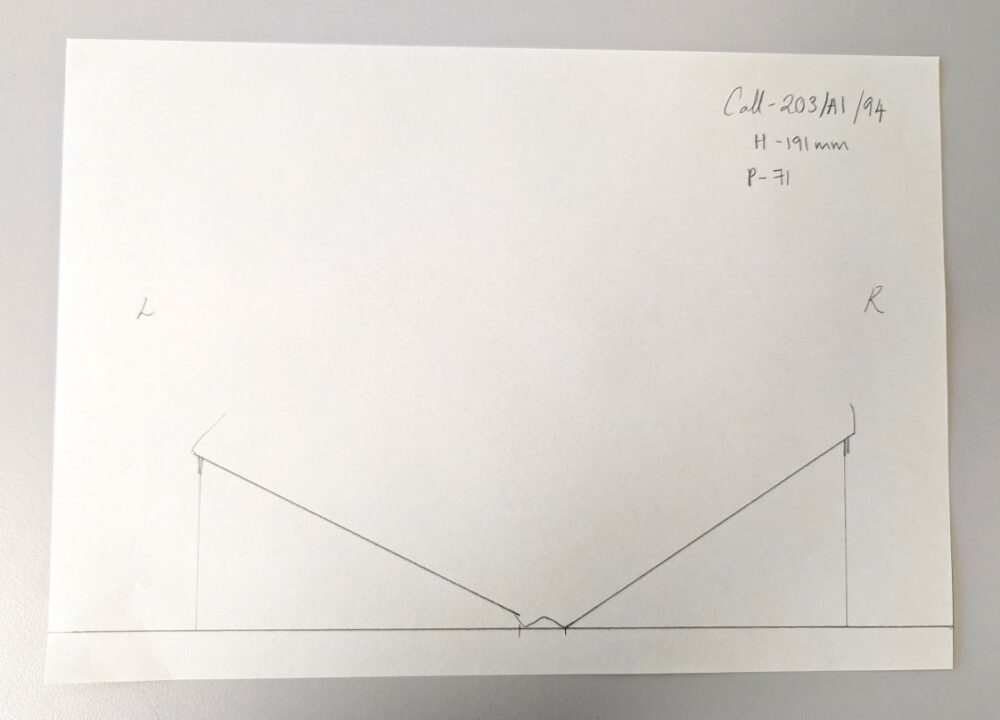In this post, our Technician, Robyn Rogers, discusses the recyclable book cradles she has developed as part of the conservation team’s ongoing work to make exhibitions at the University of Edinburgh more sustainable.
The problem: single use plastic book cradles.
The solution: fully recyclable book cradles made from archival box board.
Here at the University of Edinburgh Library we exhibit a lot of books. Our exhibitions are large, varied and nearly always feature books from our Heritage Collections. Traditionally, these books have been mounted on specially commissioned Perspex book cradles. These cradles are made to measure and fit the specific page opening of each exhibited volume. They look sleek and discreet, but they provide the support necessary for a book to be open throughout the length of a long exhibition without risking damage to the binding. Despite these advantages, Perspex mounts are often only used once. If a book is exhibited again, it is unlikely to be displayed at the same page opening. This results in a large collection of previously commissioned book cradles, kept in the hope that they will one day become useful again. Unfortunately, it is likely that most will end up in the bin.

An example of our new box board book cradles.
When asked to prepare more than thirty books for the University’s Time Travel: Charles Lyell at Work exhibition, the team and I were determined not to exacerbate this problem. We resolved to commission as few single use plastics as possible – the Perspex cradles were no longer an option! Instead, I set myself the goal of designing and preparing fully recyclable book cradles made from archival box board. After a few prototypes, and a lot of advice from our brilliant paper conservator Amanda Dodd, I was able to finalize a design that both the conservation and curatorial team were happy with. In the end, we only commissioned two Perspex mounts for the Charles Lyell exhibition – these were for two volumes with particularly complicated fold out pages.
For our current exhibition, Panoramas: the World in 360°, we needed to display several books with these complicated fold outs. With our new box board cradle design finalized, I had the time to design a cradle that could support these fold outs. This meant that we didn’t have to commission any new plastic cradles at all. Success!

The team and I busy finishing book cradles for the Charles Lyell Exhibition.
Making A Cradle
I make the skeleton of each cradle using archival box board (the same that I would use to make phase boxes), and EVA adhesive. I then cover each cradle with a light-weight buffered mountboard that matches the colour of the base of our display cases. At the end of the exhibition, I can deconstruct the cradles, cut away the adhesive, and recycle the left over board.
To support a book at the desired page opening, I first draw a profile of the book opening at an angle that properly supports the spine. I use this profile as a kind of map to determine where to fold my box board, before adhering these folds in place with a small amount of EVA. I then cut mount board to the size of the cradle, covering the skeleton so that the cradle looks sleek it’s display case.

An example of the book profiles that I draw as a plan for a book mount. I make note of the Accession Number, the height of the book, and the page number.
For books with fold out pages, I construct a kind of half cradle, with one half of the text block displayed at an angle, and the fold out displayed flat. To make the fold out support I use the same method as the cradle, first drawing a profile, and folding box board into shape.
Some especially heavy volumes need inner supports to ensure the mount is robust, and sometimes a book is so fragile, or the binding so tight, that finding a comfortable opening angle is very tricky. However, with a bit of patience most books can be supported just as well by box board as Perspex – it’s just a question of getting the angles right.

A basic book cradle and fold out book cradle supporting two volumes in the current Panoramas exhibition.
Taking the steps to make conservation and exhibition work more sustainable is a challenge, and requires us to consider the materials we use regularly from a different perspective. As collections professionals we are used to considering how materials will behave and interact with each other over a long period of time. Thinking about the end life and carbon footprint of these materials requires a different perspective. I’m excited to continue working from this perspective, and consider how I can become more sustainable in other areas of collections work. If you would like to visit the current exhibition on Victorian panoramas, so that you can see these fascinating objects (and our sustainable mounts) in person, more information can be found by clicking the link here.
